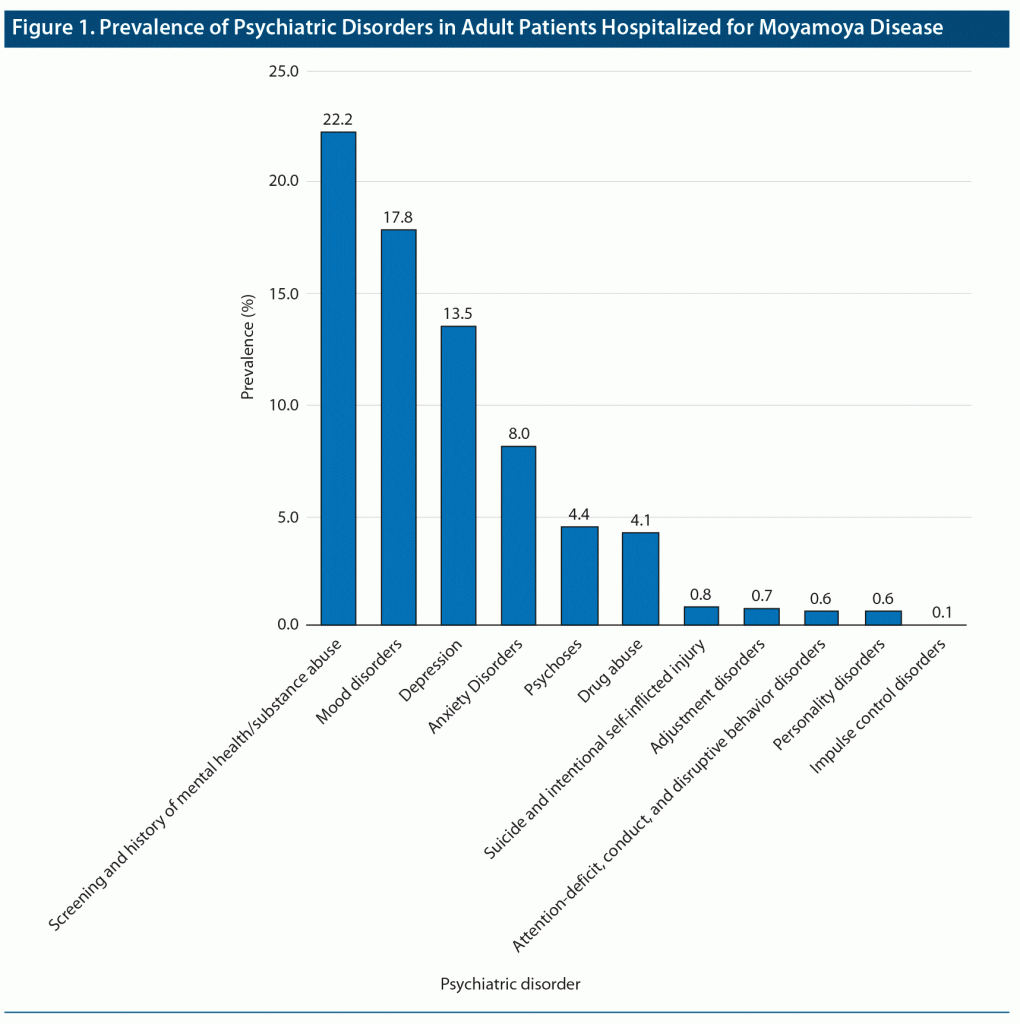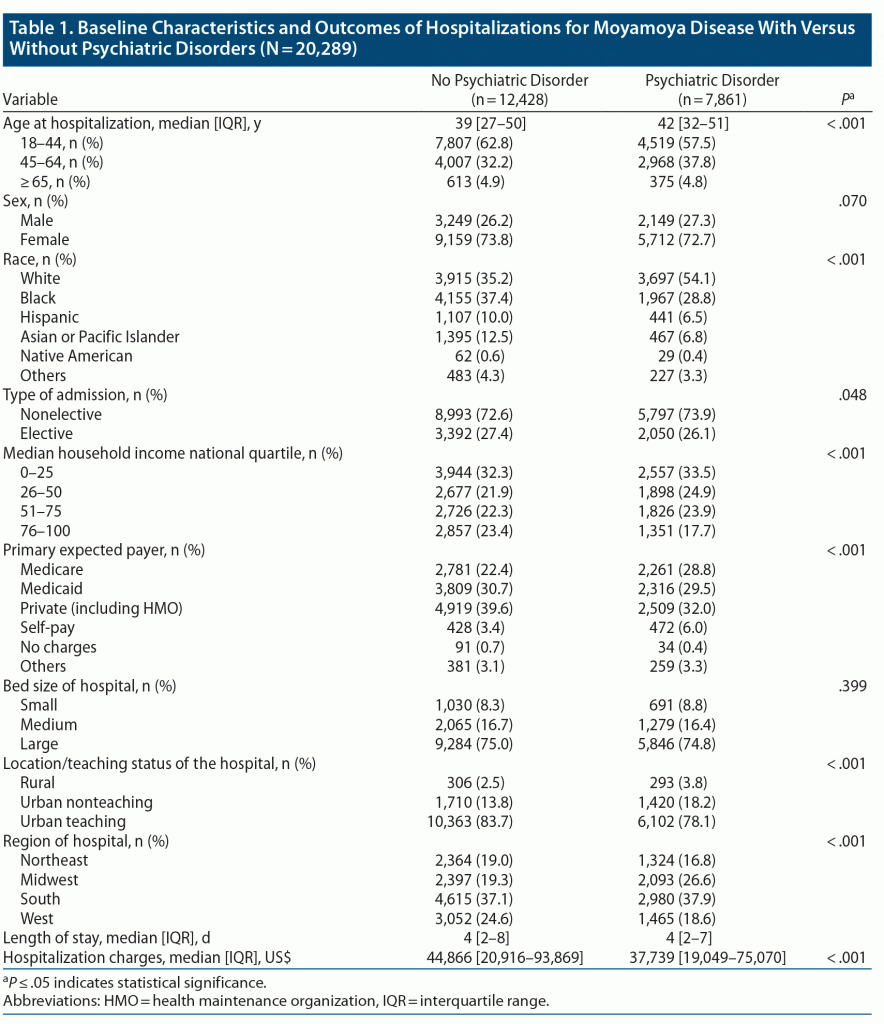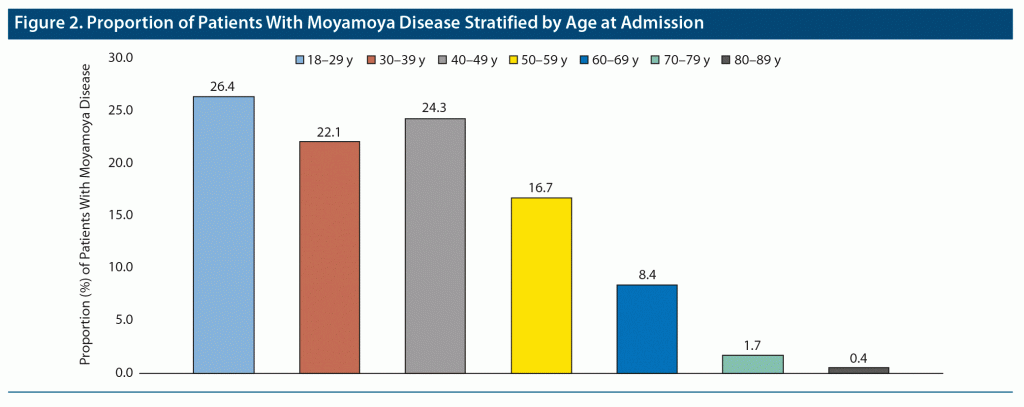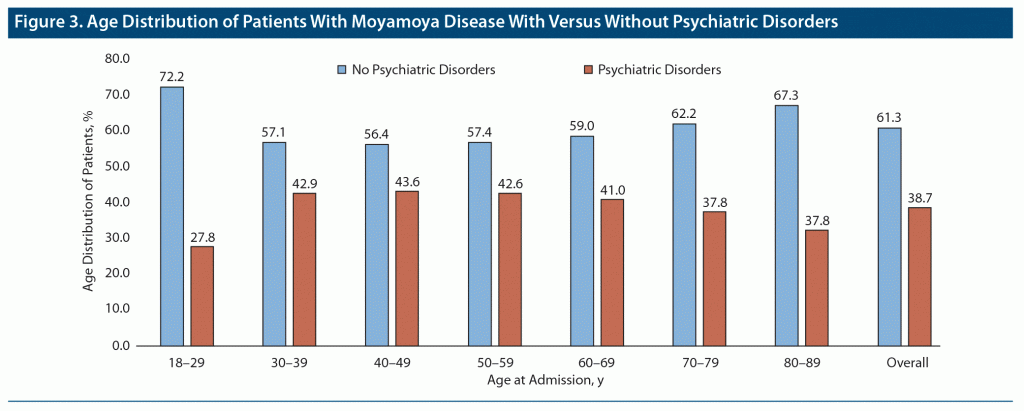ABSTRACT
Objective: Moyamoya disease is a cerebrovascular illness that causes progressive stenosis of the intracranial internal carotid arteries and their proximal branches, increasing the risk of stroke. Moyamoya disease is associated with a small number of neuropsychiatric symptoms. The objective of this study was to investigate psychiatric comorbidities and trends in patients with Moyamoya disease in the United States.
Methods: US National Inpatient Sample data from 2007 to 2014 were used for analyses in this cross-sectional study. The frequency of psychiatric and nonpsychiatric disorders among adult patients with known Moyamoya disease was assessed. Baseline demographics included in the analysis and diagnostic codes used to identify psychiatric disorders were determined. Categorical and continuous data were assessed using Pearson χ2 test and Mann-Whitney U test, respectively. All analyses were conducted using SPSS version 22.0.
Results: The prevalence of psychiatric comorbidities was 38.7% (7,861/20,289). The most common psychiatric disorders were mood disorders (17.8%) and anxiety disorders (8%). Psychosis and drug abuse were present in 4.4% and 4.1% of patients, respectively. Approximately 1 in 4 patients (22.2%) with Moyamoya disease had previously been screened for mental health or substance abuse. The rate of suicide or self-inflicted injury was 0.8%.
Conclusions: The impact of Moyamoya disease on mental health services is expected to grow, as the condition’s prevalence is increasing at a rate of approximately 1.5- to 2-fold. A multidisciplinary approach between neurology, psychiatry, and primary care can improve screening and management of comorbid psychiatric disorders.
Prim Care Companion CNS Disord 2022;24(4):21m03157
To cite: Mansuri Z, Patel K, Trivedi C, et al. Burden of psychiatric disorders in Moyamoya disease: a national inpatient perspective from 2007–2014. Prim Care Companion CNS Disord. 2022;24(4):21m03157.
To share: https://doi.org/10.4088/PCC.21m03157
© 2022 Physicians Postgraduate Press, Inc.
aDepartment of Psychiatry, Boston Children’s Hospital/Harvard Medical School, Boston, Massachusetts
bAvalon University School of Medicine, Willemstad, Curaçao, Netherlands Antilles
cDepartment of Psychiatry, Texas Tech University Health Science Center at Odessa/Permian Basin, Odessa, Texas
dDepartment of Psychiatry, Brookdale University Hospital Medical Center, Brooklyn, New York
eDepartment of Epidemiology, New York University, New York, New York
fDepartment of Psychiatry, The University of Texas Rio Grande Valley, Harlingen, Texas
gProvidence Medical Group, Newberg, Oregon
hDepartment of Psychiatry, Virginia Tech Carilion School of Medicine, Roanoke, Virginia
‡Drs Mansuri and Patel share equal contributions as first authors. Drs Lodhi and Reddy share equal contributions as senior authors.
*Corresponding author: Zeeshan Mansuri, MD, MPH, Boston Children’s Hospital/Harvard Medical School, 300 Longwood Ave, Boston, MA 02115 ([email protected]).
Moyamoya disease is a rare chronically progressive cerebrovascular disease.1 It is common among the Asian population, especially people from Japan, where it was first discovered.1 Although its etiology is not exactly clear, a Taiwanese study1,2 found an association with mutations in human RNF213 and ACTA2 genes. Moyamoya disease is bimodal with peaks between age 5 to 10 years and then between age 30–50 years; the population of patients from the second peak is smaller than the first.2,3 Family history is positive in 10%–15% of patients, and these patients have an earlier age at onset and more aggressive disease.2,3
Moyamoya disease constricts and occludes the internal carotid artery and its branches at the entrance of the circle of Willis.1–3 Collateral vessels develop to bypass the constriction/occlusion, which gives rise to a “puff of smoke” appearance for which it was given the name Moyamoya disease.1–3 Unlike Moyamoya disease, which is idiopathic, Moyamoya syndrome develops secondary to an underlying disorder like Down’s syndrome, diabetes, neoplasm, or atherosclerosis.2 A case-control study4 found that increased body mass index and homocysteine levels were linked to an increased risk of Moyamoya disease. Increased albumin and high-density lipoprotein cholesterol, on the other hand, were linked to a decreased risk of Moyamoya disease.4 Clinically, Moyamoya disease can give rise to strokes (both ischemic and hemorrhagic), transient ischemic attacks, encephalopathy, seizures, visual disturbances, developmental delay, or psychosis.2
A few publications5–7 have described the epidemiology of Moyamoya disease in the United States by using the National Inpatient Sample (NIS) and Mayo Clinic databases. Despite these wider studies, literature on psychiatric comorbidities has been relegated to case reports and small Asian population studies. Richards et al8 discussed the various case reports, limited number of small population studies, and current lack of large sample data. Kainth et al9 examined Moyamoya disease from 2005–2008 using the NIS data, but the study was limited to neurologic manifestations and did not include psychiatric comorbidities and its trends. The authors9 found that the prevalence of Moyamoya disease was increasing. To better understand the psychiatric comorbidities and trends in in the United States, we analyzed a national representative cohort of patients with Moyamoya disease hospitalized between January 2007 and December 2014 (N = 20,289).
METHODS
This cross-sectional study assessed the frequency of psychiatric and nonpsychiatric disorders among adult patients with known Moyamoya disease using the NIS (2007–2014) and the ICD-9 code 437.5.10 This ICD-9 code has a positive predictive value of 89% and higher. The NIS is a part of the Healthcare Cost and Utilization Project sponsored by the Agency for Healthcare Research and Quality. Discharge weights were used to achieve nationwide appraisals representative of over 97% of the US population. The NIS comprises cross-sectional data of nearly 35 million yearly discharges from over 1,050 hospitals and thus represents a 20% stratified sample of all nonfederal acute care hospitals from 45 states (exclusive of long-term acute care and rehabilitation centers). This study was exempt from institutional review board authorization, as it contains de-identified data.
Baseline demographics included in the analysis and diagnostic codes used to identify psychiatric disorders were determined. Categorical and continuous data were assessed using Pearson χ2 test and Mann-Whitney U test, respectively. We considered a 2-tailed P < .05 as a threshold for statistical significance. SPSS software version 22.0 (IBM, Armonk, New York) was used for all the statistical analyses.
RESULTS
The prevalence of psychiatric comorbidities was 38.7% (7,861/20,289). The most common psychiatric disorders were mood disorders (17.8%), including depression (13.5%) and anxiety disorders (8%). Psychosis and drug abuse were present in 4.4% and 4.1% of patients, respectively. Approximately 1 in 4 patients (22.2%) with Moyamoya disease had previously been screened for mental health or substance abuse. The rate of suicide or self-inflicted injury was 0.8% (Figure 1).
We also observed that females were more likely to be affected (73%) regardless of psychiatric comorbidity. The mean age of patients without psychiatric disorders was 39 years, while the mean age of those with a psychiatric disorder was 42 years. White patients accounted for the highest number of patients with Moyamoya disease (37.5%), followed by Black patients (30.0%). Stratification for psychiatric comorbidities indicated significant racial disparities—those without psychiatric disorders were predominantly Black (37.4%) followed by White (35.2%), while the group with psychiatric disorders was predominantly White (54.1%) followed by Black (28.8%). Comorbidity with a psychiatric disorder was inversely related to median household income quartile and was more common in patients from the Midwest and the South. There was no difference in the mean length of stay (days) or hospital charges in patients with or without psychiatric disorders (Table 1).
We identified 2 peaks among patients with Moyamoya disease. One peak was at age 18–29 years, while the second was at 40–49 years (Figure 2). In all age groups, the proportion of patients without psychiatric disorders exceeded the proportion of patients with psychiatric disorders. The group of patients diagnosed during the first peak had the highest difference in proportion between patients without and with psychiatric disorders (Figure 3).
DISCUSSION
Moyamoya disease is a rare chronic cerebrovascular disorder that was first reported in Japan in 1957. Although it is known to affect mainly Asian populations, the disease has recently gained broader attention in Western countries.1
The overall rate of psychiatric comorbidities in this cohort was 39%. Depression (13.5%) and anxiety disorders (8.0%) were the most encountered psychiatric conditions. Our findings are in accord with previous literature, which also notes that depression and anxiety are the most common psychiatric sequelae of Moyamoya disease.11–15 A 2005–2008 NIS study of patients with a primary diagnosis of Moyamoya disease found that strokes and transient ischemic attack were the most common reasons for hospital admissions. Moreover, a notable proportion of these patients also had comorbid hypertension and diabetes mellitus.8 There is substantial evidence suggesting stroke, hypertension, and diabetes are independently associated with poor mental health and elevated rates of depressive and anxiety disorders.16,17 However, the studies11,14,15 that evaluated patients with Moyamoya disease and history of stroke, mixed history of stroke, and no history of stroke all reported that patients were suffering from clinically significant depression or anxiety. The prevalence of depression or anxiety regardless of stroke history may be explained by the potential role of neuroinflammation in Moyamoya disease.
There is growing evidence that various inflammatory biomarkers such as adhesion molecule 1 (ICAM-1) and interleukin 1-β (Il-1b) may be present in the vessel walls of patients with Moyamoya disease.18,19 ICAM-1 and Il-1b immunoreactivity is also associated with depressive and anxiety disorders, which may explain the increased burden of those disorders in patients with Moyamoya disease.20,21
Moyamoya disease is classified as a rare disease. Most rare diseases are complex, chronic, progressive, degenerative, and often life-threatening and have no cure.2 A cross-sectional study22 that evaluated depression and anxiety in patients with different rare diseases found a majority of patients suffered from a reduced quality of life and a high percentage of depression and anxiety. Common chronic illnesses, in general, are similarly associated with poor quality of life and increased burden of depression and anxiety.16 Inadequate access to medical care, delayed diagnosis, and lack of scientific publications guiding treatment and education contribute to the high psychiatric burden seen in rare diseases.22 Detection and treatment of depression and anxiety in patients with rare chronic diseases can improve their overall health. Still, it is important to note that only 1 in 4 patients with Moyamoya disease in this study had previously received mental health and substance abuse screening.
The overall racial distribution of Moyamoya disease in this study was White (37.5%), Black (30%), Asian or Pacific islander (9.1%), and Hispanic (7.62%). The most recent US census data for racial distribution is White (60.7%), Hispanic (18.1%), Black (13.4%), and Asian (5.8%).22 Previous research found that Moyamoya disease was distributed among the races according to their relative US proportions.9 While the White race was most common in this study and the census data, the proportion of the other races are not similar to the census data.9
Stratification of the total sample for a psychiatric disorder revealed that 54.1% of White patients had a comorbid psychiatric disorder, while 35.2% did not. Conversely, all other race groups including Black, Asian and Pacific Islander, and Hispanic had more patients without a psychiatric disorder. These results may be attributed to racial and ethnic disparities in mental health care: White patients are more likely to have better access and receive treatment for mental health and substance abuse, whereas minorities have less access to care, delay/fail to seek mental health treatment, and terminate treatment prematurely in addition to provider discrimination toward minorities.24
The majority of patients with Moyamoya disease and comorbid psychiatric disorder (33.5%) were in the 0–25th quartile for median household income. The negative correlation between psychiatric disorder and median household income may be explained by the social causation hypothesis and the social drift hypothesis. The social causation hypothesis states impoverished individuals are more likely to be driven into mental illness due to heightened stress, malnutrition, social exclusion, and lower social capital, while the social drift hypothesis states that mental illness drives an individual into poverty through increased health expenditure, reduced productivity, and loss or difficulty in maintaining employment.25
From 1988 to 2004, the number of hospitalizations for patients with Moyamoya disease was 2,247.8 From 2005 to 2008, it was 7,473.9 In our study from 2007 to 2014, 20,289 patients were admitted to the hospital. Thus, the prevalence of Moyamoya disease has increased by approximately 1.5 to 2 times. This trend may represent a true increase, or it may represent an increase in awareness of the disease. Similar increases have been reported in Japan as well, where the prevalence has increased 2 times. Intensive monitoring is required to better understand this trend and the factors associated with it.
The limitations of this study should be considered prior to the interpretation of the results. First and foremost, this is a national inpatient database and does not include outpatient data. It is also difficult to be certain that the same patients are not being counted more than once due to a second need for admission. The database also does not clarify how the patients were diagnosed. Moreover, the data are restricted to approximately 20% of the stratified sample of community hospitals across the United States.
Another limitation stems from differences in coding practices, which may also influence the quality and reliability of the data. The rarity of Moyamoya disease leads to limited potential for coding, which essentially increases specificity, though the number of cases reported in this study is still an underestimation of the true burden of the disease. Additionally, ICD-9 code 7437.5 does not differentiate between Moyamoya disease and Moyamoya syndrome, meaning that we cannot say definitively if the comorbid psychiatric conditions are associated with Moyamoya disease or with secondary health conditions. Finally, we do not have data for patients aged < 18 years; thus, we cannot comment on pediatric cases of Moyamoya disease, and our observations and conclusions are limited to patients aged ≥ 18 years.
CONCLUSIONS
Our study is the first to enumerate the psychiatric comorbidities in Moyamoya disease using a nationally representative 7-year dataset. Over one-third of patients with Moyamoya disease suffer from a psychiatric disorder, with depression and anxiety being the most common, which is higher than previous estimates. The impact of Moyamoya disease on mental health services is expected to grow, as the condition’s prevalence is increasing at a rate approximately 1.5- to 2-fold. Only 25% of patients with Moyamoya disease had previously received mental health and substance abuse screenings. With increasing prevalence and given that Moyamoya disease is more severe in the US population compared to that of Japan, we hope that this study will add to the currently available data and improve screening in these patients. Because of the multifactorial pathogenesis of psychiatric illness in Moyamoya disease, a multidisciplinary approach between neurology, psychiatry, and primary care can improve screening and management of comorbid psychiatric disorders. Further studies are needed to analyze the reason behind the increased prevalence and differences in the disease between Asian and US populations.
Submitted: September 26, 2021; accepted January 19, 2022.
Published online: August 23, 2022.
Relevant financial relationships: None.
Funding/support: None.
Clinical Points
- The medical comorbidities of Moyamoya disease are well-documented, but the psychiatric associations are ambiguous and lacking in information.
- Because of the multifactorial pathogenesis of psychiatric illness in Moyamoya disease, a multidisciplinary approach between neurology, psychiatry, and primary care can improve screening and management of comorbid psychiatric disorders.
References (25)

- Takeuchi K, Shimizu K. Hypoplasia of the bilateral internal carotid arteries. Brain Nerve. 1957;9:37–43.
- Scott RM. Moyamoya Syndrome. In: NORD Guide to Rare Disorders. Philadelphia, PA: Lippincott Williams & Wilkins; 2003:559.
- Kim JS. Moyamoya disease: epidemiology, clinical features, and diagnosis. J Stroke. 2016;18(1):2–11. PubMed CrossRef
- Ge P, Zhang Q, Ye X, et al. Modifiable risk factors associated with Moyamoya disease: a case-control study. Stroke. 2020;51(8):2472–2479. PubMed CrossRef
- Hallemeier CL, Rich KM, Grubb RL Jr, et al. Clinical features and outcome in North American adults with moyamoya phenomenon. Stroke. 2006;37(6):1490–1496. PubMed CrossRef
- Starke RM, Crowley RW, Maltenfort M, et al. Moyamoya disorder in the United States. Neurosurgery. 2012;71(1):93–99. PubMed CrossRef
- Lee DJ, Liebeskind DS. Characterization of inpatient Moyamoya in the United States: 1988-2004. Front Neurol. 2011;2:43. PubMed CrossRef
- Richards M, Grzenda A, Nelson E, et al. Psychiatric comorbidity in Moyamoya disease and preliminary guidelines for treatment. Am J Psychiatry. 2019;176(4):269–274. PubMed CrossRef
- Kainth D, Chaudhry SA, Kainth H, et al. Epidemiological and clinical features of Moyamoya disease in the USA. Neuroepidemiology. 2013;40(4):282–287. PubMed CrossRef
- HCUP-US NIS Overview. HCUP-US NIS Overview website. Accessed May 9, 2021. https://www.hcup-us.ahrq.gov/nisoverview.jsp
- Festa JR, Schwarz LR, Pliskin N, et al. Neurocognitive dysfunction in adult Moyamoya disease. J Neurol. 2010;257(5):806–815. PubMed CrossRef
- Su SH, Hai J, Zhang L, et al. Quality of life and psychological impact in adult patients with hemorrhagic Moyamoya disease who received no surgical revascularization. J Neurol Sci. 2013;328(1-2):32–36. PubMed CrossRef
- Liu C, Yi X, Li T, et al. Associations of depression, anxiety and PTSD with neurological disability and cognitive impairment in survivors of Moyamoya disease. Psychol Health Med. 2019;24(1):43–50. PubMed CrossRef
- Karzmark P, Zeifert PD, Bell-Stephens TE, et al. Neurocognitive impairment in adults with Moyamoya disease without stroke. Neurosurgery. 2012;70(3):634–638. PubMed CrossRef
- Karzmark P, Zeifert PD, Tan S, et al. Effect of Moyamoya disease on neuropsychological functioning in adults. Neurosurgery. 2008;62(5):1048–1051, discussion 1051–1052. PubMed CrossRef
- Clarke DM, Currie KC. Depression, anxiety and their relationship with chronic diseases: a review of the epidemiology, risk and treatment evidence. Med J Aust. 2009;190(suppl):S54–S60. PubMed CrossRef
- Graham N, Smith DJ. Comorbidity of depression and anxiety disorders in patients with hypertension. J Hypertens. 2016;34(3):397–398. PubMed CrossRef
- Smith ER. Moyamoya biomarkers. J Korean Neurosurg Soc. 2015;57(6):415–421. PubMed CrossRef
- Young AM, Karri SK, Ogilvy CS, et al. Is there a role for treating inflammation in Moyamoya disease? a review of histopathology, genetics, and signaling cascades. Front Neurol. 2013;4:105. PubMed CrossRef
- Miguel-Hidalgo JJ, Overholser JC, Jurjus GJ, et al. Vascular and extravascular immunoreactivity for intercellular adhesion molecule 1 in the orbitofrontal cortex of subjects with major depression: age-dependent changes. J Affect Disord. 2011;132(3):422–431. PubMed CrossRef
- Felger JC. Imaging the role of inflammation in mood and anxiety-related disorders. Curr Neuropharmacol. 2018;16(5):533–558. PubMed CrossRef
- Uhlenbusch N, Löwe B, Härter M, et al. Depression and anxiety in patients with different rare chronic diseases: a cross-sectional study. PLoS One. 2019;14(2):e0211343. PubMed CrossRef
- United States Census Bureau. Accessed May 9, 2021. https://www.census.gov/quickfacts/fact/table/US/PST045221
- McGuire TG, Miranda J. New evidence regarding racial and ethnic disparities in mental health: policy implications. Health Aff (Millwood). 2008;27(2):393–403. PubMed CrossRef
- Lund C, De Silva M, Plagerson S, et al. Poverty and mental disorders: breaking the cycle in low-income and middle-income countries. Lancet. 2011;378(9801):1502–1514. PubMed CrossRef
Enjoy free PDF downloads as part of your membership!
Save
Cite
Advertisement
GAM ID: sidebar-top








